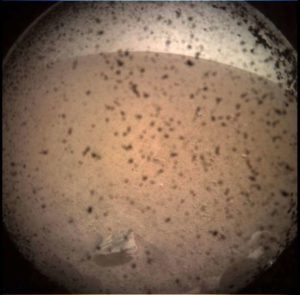 1
1

Arkaim and the texts of Rgveda about his builders
 25. 04. 2024
25. 04. 2024



 04. 12. 2018
04. 12. 2018

Mars has just adopted his newest robotic resident. NASA is exploring the interior through seismic survey, geodesy and heat transfer (InSight). The module successfully landed on the red planet after nearly a seven-month journey from Earth, long 300 million miles (458 million miles).
InSight's two-year mission will study deep the interior of Marsto learn, how all the celestial bodies were created with rocky surfaces, including the Earth and the Moon. InSight he started from Vandenberg Air Base in California 5. May 2018. The module landed on Monday 26. November near the equator of Mars, on the west side of the flat, smooth lava region of Elysium Planitia with a signal confirming the completed landing sequence in 11: 52 PST (2: 52 EST).
NASA Administrator Jim Bridenstine says:
“Today, we have successfully landed on Mars for the eighth time in human history. InSight will study the inside of Mars and teach us how to prepare astronauts to be sent to the Moon and later to Mars. This success represents the ingenuity of America and our international partners and serves as a testament to the determination and perseverance of our team. The best of NASA is coming and it will be soon. ”
The landing signal was transmitted to NASA's Jet Propulsion Laboratory (JPL) in Pasadena, California through two small experimental CubeSats Mars Cube One (Marco CubeSats) models. They were launched on the same rocket as InSight and followed by the Mars landing module. They are the first CubeSats sent to deep space. After successfully completing several communication and experimental navigation flights, the Marco twins were set to receive transmissions during the InSight entry, descent, and landing.

The NASA InSight Mars spacecraft acquired this image of the area in front of the module using its ICC. This picture was taken on 26. November 2018, Sol 0 on the InSight mission, where the local average sunshine time for the images was 13: 34: 21. Each ICC image has a field of view 124 x 124 degrees.
InSight Project Manager Tom Hoffman says:
"We hit the atmosphere of Mars at a speed of 19 km / h and the whole sequence, landing on the surface, lasted only six and a half minutes. In this short time, InSight had to perform dozens of operations on its own and perform them flawlessly - and apparently that was exactly what our spaceship was doing. "
A successful landing confirmation is not the end of landing calls on a red planet. InSight's surface phase began a minute after the landing. One of the first tasks is to deploy two decanal solar panels to provide power. This process begins 16 minutes after landing and takes 16 minutes. InSight expects Monday to confirm that the module has successfully developed solar panels. Verification will come from the spacecraft NASA Odyssey, which is currently circling Mars. This signal is expected to reach InSight control at the JPL about five and a half hours after landing.
“We are powered by solar energy, so stretching panels and running is a big problem. But for the first time we are well on our way to explore what's inside Mars. ”

Mars InSight team members Kris Bruvold on the left and Sandy Krasner respond after receiving a confirmation that the Mars InSight module is on Monday 26. November 2018 successfully landed on Mars, inside mission support (MSA) at the NASA Jet Propulsion Lab in Pasadena, California.
InSight will begin collecting scientific data during the first week after landing, although teams will focus on preparing InSight tools on Martian soil. At least two days after landing, the engineering team will deploy an InSight robotic arm with a length of 1,8 meter to capture the landscape.
Bruce Banerdt, senior research officer at InSight, says:
"The landing was exciting, but I look forward to drilling."
When the first pictures arrive, our engineering and science teams will get into the field and start planning where to deploy our scientific instruments. Within two to three months, the arm will deploy the major scientific tools of the mission, SEIS, and Heat Flow and Physical Characteristics (HP3) tools. InSight will work on the surface for one year plus 40 days or 24. November 2020.
The objectives of the two small MarCo missions that carried InSight telemetry were completed after their resettlement.
Joel Krajewski, Marco Project Manager at JPL, says:
“This is a huge leap. I think CubeSats has a great future outside Earth's orbit, and the MarCO team is happy to follow this unexplored path. Experimental MarCo CubeSats also opened new doors for smaller planetary spacecraft. The success of these two unique missions honors hundreds of talented engineers and scientists. ”
JPL runs InSight for NASA's headquarters. InSight is part of Discovery, run by the Marshall Space Flight Center in Huntsville, Alabama. MarCO CubeSats were built and managed by JPL. Lockheed Martin Space in Denver has built an InSight spacecraft including a cruise and landing module and supports space mission operations for missions.
The project was also supported by a number of European partners:
For more information on InSight, visit: https://www.nasa.gov/insight/
For more information on MarCO, please visit: https://www.jpl.nasa.gov/cubesat/missions/marco.php
Learn more about NASA missions on Mars: https://www.nasa.gov/mars